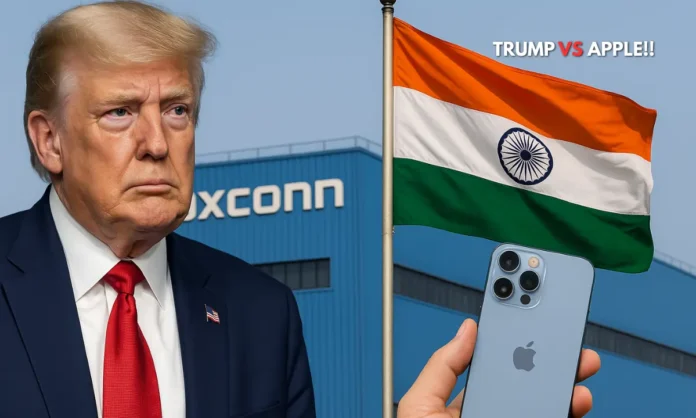Summary
- Donald Trump criticized Apple for expanding iPhone production in India instead of the U.S.
- Indian officials dismissed the remark, reaffirming Apple’s commitment to its growing base in India.
- India now produces 15% of global iPhones, with $22 billion in iPhone assembly recorded in FY25.
Trump’s Apple Jab and India’s Cool Rebuttal
India has issued a calm but confident response to former U.S. President Donald Trump’s remarks urging Apple to halt iPhone production in India. Speaking in Doha, Trump claimed to have told Apple CEO Tim Cook, “I don’t want you building in India,” stirring concerns about Apple’s strategic global positioning. But in New Delhi, officials were unfazed. “No comments,” one senior official said pointedly. Then, a more nuanced reply followed: India, they asserted, is no longer just a participant but a “significant mobile manufacturing hub.”
With $22 billion worth of iPhones assembled in India in FY25 and 3 million units shipped to the U.S. in March alone, Apple’s India pivot is already reshaping global supply chains. Trump’s political posturing, Indian officials implied, can’t override the economic calculus behind Cupertino’s India strategy. And Apple itself, in backchannel communications, has reassured Indian authorities that its India investment remains firm.
Trump’s words may be blunt, but India’s rise in electronics manufacturing is no longer up for negotiation—it’s simply good business.
President Trump tells Apple not to invest in India to make iPhones. India’s reckless behavior (becoming the first nuclear power to attack another atomic power with missiles) has exposed Indian vulnerabilities and greatly disappointed its friends and foes, which I feel is the… pic.twitter.com/tAUPKQRdQu
— Dr M. Ali Shaikh (@DrMAliShaikh) May 15, 2025
iPhones, Not Rhetoric: What Apple’s Data Says
- India now assembles 15% of Apple’s global iPhones, worth $22 billion in FY25.
- In March alone, India exported 3 million iPhones to the U.S., 98% of Apple’s overseas shipments.
- Foxconn and Pegatron lead manufacturing, with Tata Electronics also scaling up operations.
- Apple has reportedly confirmed to Indian officials that its plans remain unchanged post-Trump’s remarks.
The core of Trump’s statement—his disapproval of Apple manufacturing iPhones in India—may resonate with his “America First” base. But for Apple, the shift is based on strategy, not sentiment. Manufacturing in India offers multiple advantages: lower labor costs, a stable electronics supply chain, and political incentives under India’s PLI (Production-Linked Incentive) scheme.
Foxconn, Pegatron, and Tata Electronics have rapidly scaled up operations in India. The Telangana plant that now produces AirPods for global exports is one of several new links in the expanding Apple–India chain.
In response to Trump’s jab, Indian officials didn’t just deflect—they pointed to data. Apple’s India production jumped 60% in one year, and the country now handles the majority of Apple’s non-China exports. With Foxconn adding thousands of jobs and expanding its plants, and India’s exports of smartphones rising steadily, the facts are hard to ignore—even for Trump.
Make in India > Make in Rhetoric
- Indian officials say companies make decisions based on competitiveness, not campaign lines.
- India’s labor force and regulatory reforms have attracted global brands beyond Apple.
- The Apple ecosystem in India has created over 200,000 jobs and dozens of Tier-1 and Tier-2 suppliers.
- FY25 smartphone exports from India hit ₹1.5 lakh crore, led by Apple.
The response from India’s top trade officials centered on realism: “Apple would be more concerned about where they would find manufacturing competitiveness,” one said, underlining the apolitical nature of multinational business decisions.
India’s edge lies not just in cheaper labor, but in scalable infrastructure, a growing component ecosystem, and predictability in policy. Apple’s own India footprint is testament to that. Over two lakh jobs have been generated across direct assembly and supplier networks. Firms like Salcomp and Sunwoda have expanded alongside Apple, mirroring the “ecosystem effect” seen in China a decade ago.
India’s focus is simple—become indispensable to global value chains. Whether it’s Apple, Samsung, or Google, the playbook is the same: offer reliable scale, political stability, and economic efficiency. In that context, Trump’s rhetoric seems like a rerun from a different era.
Trade, Tension, and the $45 Billion Surplus
- India enjoys a $45 billion trade surplus with the U.S., a long-standing concern for Trump.
- India–U.S. trade hit $129 billion in 2024, with electronics and pharma leading exports.
- Commerce Minister Piyush Goyal is heading to the U.S. to reinforce trade and investment ties.
- Apple’s India success aligns with U.S. nearshoring strategies away from China.
Trade friction is not new. Trump has previously flagged India’s surplus as unfair, and his administration raised tariffs on Indian goods during his first term. But today’s reality is more interwoven. With China no longer seen as a stable manufacturing hub, India has emerged as the U.S.’s top nearshoring partner for electronics and pharmaceuticals.
Piyush Goyal’s upcoming visit to Washington aims to build on this momentum. Talks are expected to cover semiconductors, EVs, digital payments, and defense procurement—all sectors where India is seeking deeper alignment with American industries.
Interestingly, Apple’s India expansion also serves American interests: it diversifies U.S. supply chains, reduces dependence on China, and bolsters allies in Asia. Trump’s complaint, therefore, runs counter to current U.S. policy direction under both Republican and Democrat leaderships.
iPhones, Influence, and India’s Rise
Trump may not like where Apple is building, but India isn’t blinking. With strategic clarity and industrial confidence, New Delhi knows that global tech flows not toward speeches—but toward supply chains.
In a world where resilience trumps nationalism, Apple’s India move is less about ideology and more about inevitability. India is no longer the underdog—it’s the factory floor for tomorrow’s iPhones, and perhaps tomorrow’s geopolitics too.


